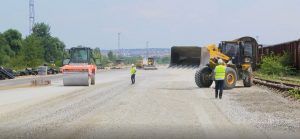 Infrastruktura Železnica Srbije, the infrastructure manager of Serbia, has announced that rail investment plans for 2022 cover the reconstruction and modernisation of 300 km of rail lines.
Infrastruktura Železnica Srbije, the infrastructure manager of Serbia, has announced that rail investment plans for 2022 cover the reconstruction and modernisation of 300 km of rail lines.
The company is currently implementing the construction of the 75 km Belgrade-Novi Sad high-speed railway which is in the final phase. The line will allow trains to run at speeds of up to 200 km/h and static tests on the catenary and sigalling, security and telecommunication systems are currently carried out. Following these tests, DB Systemtechnik will perform dynamic testing on the Belgrade – Stara Pazova section in January and February and the opening of the Belgrade – Novi Sad line is expected to take place in March. The line includes the Cortanovci tunnel and viaduct completed in August 2021.
Recently construction work has begun on the 108 km Novi Sad – Subotica line, which is part of the Novi Sad – Subotica – Kelebija mainline for which the construction of an underpass in Kisačka Street in Novi Sad is underway, as well as the reconstruction of the Novi Sad railway station. The planned completion of works on the section Novi Sad – Kelebija is scheduled for November 2024.
The infrastructure manager is also implementing the modernisation of the 68.8 km Jajinci – Mala Krsna line, on the Corridor X, which is also in the final phase. In September construction works have been launched on the 22.8 km Niš – Brestovac line creating the rail corridor from Niš to Preševo while in October the reconstruction of the 26.6 km Subotica – Horgoš rail section started which will provide transport connection to the border with Hungary through Szeged. EUR 87 million is the value of the project which include the reconstruction of 26.63 km long railway between Subotica and Horgoš. The entire line is 39.2 km long, of which 12.6 km in Hungary and 26.6 km in Serbia. The project is expected to be completed in November 2020 when the trains will run at up to 120 km/h.
Other ongoing works include the modernisation of the 23 km Niš – Brestovac line will be completed in 2023 including the construction of eight bridges with the longest one – of 180 metres – being constructed over the South Morava River, near Malošište. The reconstructed railway Niš – Brestovac will allow trains to run at speeds of up to 120 km/h.
A tender process has been completed for the construction of a tunnel on the 17 km Stalac – Djunis line on the Belgrade – Niš corridor. The project includes the rehabilitation of the single-track section section and the construction of its second track as well as the construction of 7 km tunnel sections.
In addition, the tender procedure for the modernisation of the Niš – Dimitrovgrad railway is still ongoing.
As part of country’s 2021 rail investment plans, 450 km lines have been modernised and in the past seven years, Serbia has constructed, reconstructed and modernised 750 km rail lines including 227 km for accommodate high speeds and 529 km of regional lines which were completed.
Serbia is currently preparing the documentation for 720 km of rail lines which cover reconstruction, upgrade and construction works in the next years. These projects include:
- Sićevo – Dimitrovgrad project covering a bypass around Niš;
- Stalać – Đunis;
- Valjevo – Vrbnica situated on the Bar railway;
- The Beli Potok – Vinča – Pancevo bypass;
- Resnik – Velika Plana (84 km); Velika Plana – Niš (111 km); Niš – Preševo – state border with Northern Macedonia (132 km); and
- Stara Pazova – Sid.
Share on:



